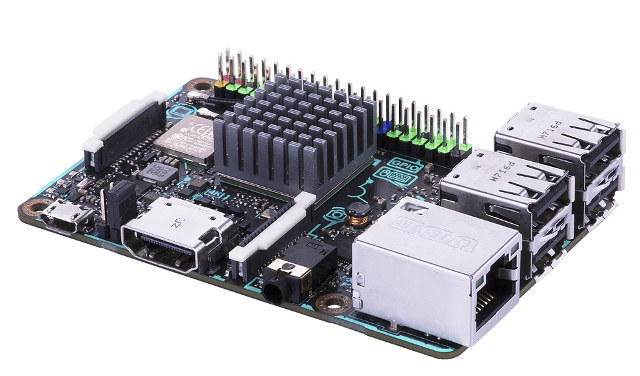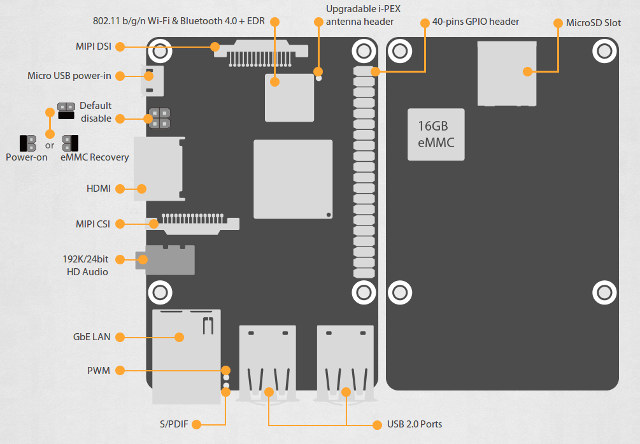ASUS Tinker Board generated a lot of buzz on this blog when it launched last year as a large company like ASUS entered the maker market with a Raspberry Pi 3 competitor with more powerful and 4K capable Rockchip RK3288 processor.
The company has now announced an update at CES 2018 with Tinker Board S with the same features, except for the additional of 16GB eMMC flash and a few other minor changes.

ASUS Tinker Board S specifications:
- SoC – Rockchip RK3288 quad core ARM Cortex A17 processor up to 1.8 GHz with Mali-T764 GPU supporting OpenGL ES 1.1/2.0 /3.0, and OpenCL 1.1
- System Memory – 2GB dual channel LPDDR3
- Storage – 16GB eMMC flash + micro SD slot
- Video output & Display I/F
- 1x HDMI 2.0 up to 3840×2160 @ 30 Hz with HDMI CEC
- 1x 15-pin MIPI DSI supporting HD resolution
- Audio – 1x 3.5mm audio jack with plug-in detection and auto switch; Realtek ALC4040 HD codec with 192KHz/24-bit audio
- Camera I/F – 1x 15-pin MIPI CSI connector
- Connectivity – Gigabit Ethernet, 802.11 b/g/n WiFi, Bluetooth 4.0 + EDR
- USB – 4x USB 2.0 host ports, 1x micro USB port (for power)
- Expansion Headers
- 40-pin Raspberry Pi compatible header with up to 28x GPIOs, 2x SPI, 2x I2C, 4x UART, 2x PWM, 1x PCM/I2S with slave mode, 5V, 3.3V, and GND
- 2-pin contact point with 1x PWM signal, 1x S/PDIF signal
- 2-pin power-on-header
- Misc – Button, unpopulated fan header
- Power Supply – 5V/2-3A via micro USB port with support for low voltage detection
- Dimensions – 85.6 x 54 cm
- Weight – 55 grams

Just like its predecessor, Tinker Board S can run Debian 9 + LXDE based Tinker OS, as well as Android Tinker OS, and Flint OS. The board also supports popular programs such as Kodi medi center or Lakka and RetroPie retro gaming platforms, as well as expansion boards like HiFiBerry sound cards or MATRIX Creator IoT / sensors board.
The Tinkerboard S will be available in Q1 2018 for $79.99 MSRP. Visit the product page for documentation (WiP) and more details.

Jean-Luc started CNX Software in 2010 as a part-time endeavor, before quitting his job as a software engineering manager, and starting to write daily news, and reviews full time later in 2011.
Support CNX Software! Donate via cryptocurrencies, become a Patron on Patreon, or purchase goods on Amazon or Aliexpress. We also use affiliate links in articles to earn commissions if you make a purchase after clicking on those links.





Only thing I like about Asus Tinker:
“2GB dual channel LPDDR3”
Wonder what “sysbench –test=memory –memory-block-size=1M –memory-total-size=2G run” yields with Dual channel mem channel on this one?
On S905 i get ~ 2000M/s.
The cpu is more powerful than the RPi3 but it is not able to run at its full speed for more than a few seconds before throttling with the stock heatsink, and after a few minutes of cpu-intensive computations (like a compilation) you end up with a cpu throttling at 800MHz and running much slower than a pi3..
@fossxplorer
For an ODROID-C2: https://pastebin.com/7Xa7Kdi6
@naide
Considering the Rpi3 throttles down to 600MHz under load as well, I’ll put my money on an 800MHz A17 vs a 600MHz A53 any day.
At least the ASUS has a heatsink.
Still using the stupid micro-USB for power. Why don’t vendors at least upgrade to use USB Type-C for power input?
Nice. But these boards need an option for more RAM. It seems like every one of these boards comes up short RAM wise.
The other thing is the GPU, anybody know how Linux drivers are coming along? For some applicaiitons you really need a complete driver solution for the GPU
Small improvements on the board and eMMC, that’s it? The board needs a better heat sink/system and software (Tinker OS).
Still only a 32-bit processor core (ARM Cortex A17) in now mostly 64 bit world, and still USB 2.0.
Maybe the next iteration (if there is one) will overcome these limitations.
@willmore
Thanks. That’s ~ 50% better than my el cheapo S905 box. I assume Hardkernel is using some quality RAM chips 🙂
for Asus Tinker team…I wish:
a) power supply on 2 pin dedicated robust connector, not on micro-usb (non sense)
b) 4 GB on dual channel
c) 2 dedicated holes (better stability with 4) for a customized larged heatsink.
@David Frantz I got two last year when it came out and I am using one as my everyday media center. I did try a lot of things to be able to read various video format and quality, the debian distrib is a real pain. The only way I manage to read x265 properly is with the preinstalled player which is really not user friendly, I tried with VLC, but no luck. And chrome is crashing often and even unexpected reboot and other boring behavior.
But the android distro is quite working, at the condition you can do without play store (didn’t try for a while, but it was crashing all the time, really not usable). I have installed Kodi on it and everything plays smoothly. Almost never any crash. I also stream video game using moonlight from my computer, it’s working great with x265 and a latency of 15ms. I had the same install on an Odroid C2, latency was 50ms.
@fossxplorer
They have actual engineers designing their boards. 🙂